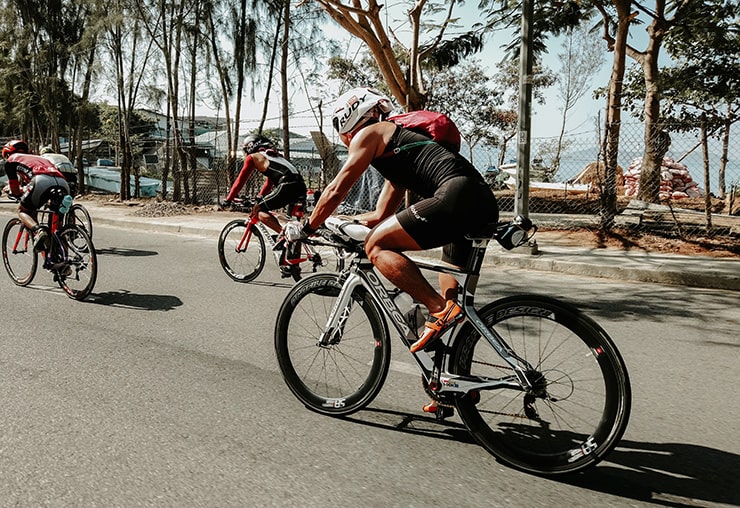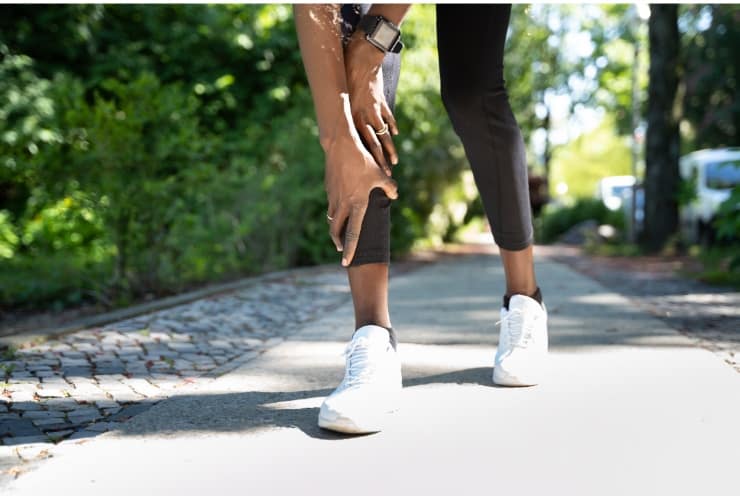Whether you’re an avid cyclist or prefer other exercises like running or walking, you may wonder how you can still exercise with shin splints.
Luckily, cycling is a low-impact exercise, meaning you can still bike when recovering from shin splints. However, there are a few ways to make the process more smooth and avoid making your shin splints worse.
This article will explain how to bike with shin splints and provide prevention and recovery tips.
Key Takeaways
- You can bike with shin splints, but you should stretch, wrap your leg, wear high-support shoes, and adjust your saddle position.
- To prevent shin pain while cycling, prioritize rest, stretch regularly, and gradually increase your workout intensity.
- To recover quickly from shin splints, make sure to rest, ice your leg, use anti-inflammatory medication, wear orthotics while walking, and slowly ease back into exercising when recovered.
What Are Shin Splints?
Shin splints, also known as medial tibial stress syndrome, tend to cause pain in the large shin bone in the front of your leg. Shin splints occur when the muscles, tissue, and tendons around the tibia become inflamed.
Some common symptoms of shin splints are soreness, pain, tenderness, and swelling. You can typically treat shin splints with an ice pack and over-the-counter drugs. The average recovery time for shin splints can vary greatly; the injury can last anywhere from a few days to a few weeks.
Is It Okay to Bike With Shin Splints?
Shin splints can be annoying and may take a few weeks to heal. While intense exercise like running is not recommended, is biking okay?
It is okay to partake in low-impact exercises such as biking and swimming when recovering from shin splints. However, you should stop immediately if you feel pain while exercising.
Depending on your injury, it is possible for continuous pressure and exercise to cause a stress fracture. This is why you should assess for pain and take the proper precautionary steps, as listed below, to prevent excess stress during recovery.
How to Bike With Shin Splints

While it is okay to bike with shin splints, you can do a few things to prevent stress fractures and further pain. While you may not need to follow all of these tips, even just implementing one or two can make a big difference.
Wrap Your Leg
A simple way to prevent shin pain while biking is to wrap your leg.
There are a few options when it comes to this, but the easiest method is to buy a shin splint compression wrap. This type of wrap will be easiest to use as you simply put it on and tighten it. Wrapping your leg will decrease inflammation.
Stretch
Stretching your shins and surrounding muscles can greatly help to reduce symptoms and prevent further injuries like stress fractures.
Some top stretches for this type of injury are the gastrocnemius stretch, the tibialis anterior stretch, the posterior leg stretch, and the soleus stretch.
Wear Proper Footwear
Even though biking is a non-impact exercise, wearing improper footwear can worsen shin splints.
Ideally, you should wear shoes with high support and stability. Your shoes should feel firm yet comfortable.
Adjust Your Saddle Position
It may be surprising to hear that your saddle height can cause discomfort. An improper bike fit can lead to poor form and cause pain in your shins.
First, increase your saddle height, as this can decrease your chances of dropping your heel during the downward pedal stroke. It will also help prevent your ankle from sitting at an awkward angle. Moving your seat back a bit could also help, as this will decrease pressure on your anterior shins.
Can I Get Shin Splints From Cycling?
While cycling is low impact, that doesn’t mean it can’t cause injuries. So is it possible to get shin splints from cycling?
While cycling can cause shin pain, it’s unlikely to cause shin splints. However, this non-impact activity may lead to shin splints if you have poor form. Excessive riding, overusing certain muscles, and failing to take breaks can cause shin splints.
Experiencing shin pain while cycling may also be due to chronic exertional compartment syndrome. This refers to a nerve and muscle condition that leads to inflammation and pain. This syndrome is more common in sports involving repetitive motions, such as cycling.
How to Prevent Shin Pain

Whether you ride a stationary bike or are into road cycling, there are a few ways to prevent shin pain from cycling, including stretching and resting. Not only do these tips work well for biking, but they are effective for other sports as well. Let’s get into it.
Stretch Regularly
Unfortunately, stretching is often taken for granted. Many people only stretch to prevent soreness after a workout; however, it can also help prevent shin pain.
Stretching will help warm up your shins and surrounding muscles to avoid pain or small tears from the sudden movement. Remember that it is important to stretch regularly, not just before you bike.
Prioritize Rest
Compared to high-impact sports, it can be easy to hop on a bike every day and feel like there aren’t any repercussions. However, it is important to prioritize rest to avoid overuse and injury like shin splints. Try to leave a day or two in between intense workouts to allow your muscles to heal.
Gradual Increase in Intensity
A sudden increase in intensity can cause shin splints, so it’s a good idea to gradually increase your intensity to allow your muscles to warm up.
An intense cycling workout is not bad; however, if you plan an intense bike ride, start slowly and gradually increase your speed or resistance. Avoiding jumping from low to high speed/resistance in a matter of seconds will prevent shin splints and other types of lower leg injuries.
Shin Splint Recovery Tips
While it’s okay to hop on your bike with shin splints to maintain fitness, you can do a few things to recover whenever you’re off the bike.
Shin splints will typically go away on their own with the aid of a few things you can pick up at your local drugstore. Keep reading to find out the best ways to recover quickly.
- Rest. While you need to incorporate rest in your schedule when you don’t have shin splints, it’s also critical to rest when you’re recovering. Avoid strenuous movement or exercise, as this will worsen your shin splints.
- Use ice every 10-20 minutes. Icing your legs every 10-20 minutes will help reduce swelling and pain. You should ideally ice your legs about four times a day, depending on how you’re feeling. Doing this routine for a few days should help you heal quickly.
- Pain Relievers and Supplements. Shin splints can be a painful condition, but there are some over-the-counter medications and vitamins that will help increase comfort. Anti-inflammatory medications such as ibuprofen or aspirin will work well. Vitamin D3 may also help with the recovery process.
- Orthotics. It’s a good idea to put orthotics in your everyday footwear to help relieve pressure on your shin muscles. You can either purchase custom-made orthotics or insoles at the drug store. Both options will help give you proper support.
- Ease into activity slowly when recovered. Once you’ve recovered from shin splints, slowly ease back into exercise. Start with lower gears and speeds as you get back to normal. Stop immediately if the exercise is painful in any way, as this indicates you need more time to heal.
Final Thoughts
Cycling with shin splints is okay as long as the activity does not cause pain. Ideally, you should wrap your leg, stretch, wear proper footwear and adjust your saddle height to prevent further injury.
Once you have recovered, make sure to stretch regularly and prioritize rest to prevent cycling shin pain in the future.
Did you enjoy this article? If so, be sure to leave a comment and share!

